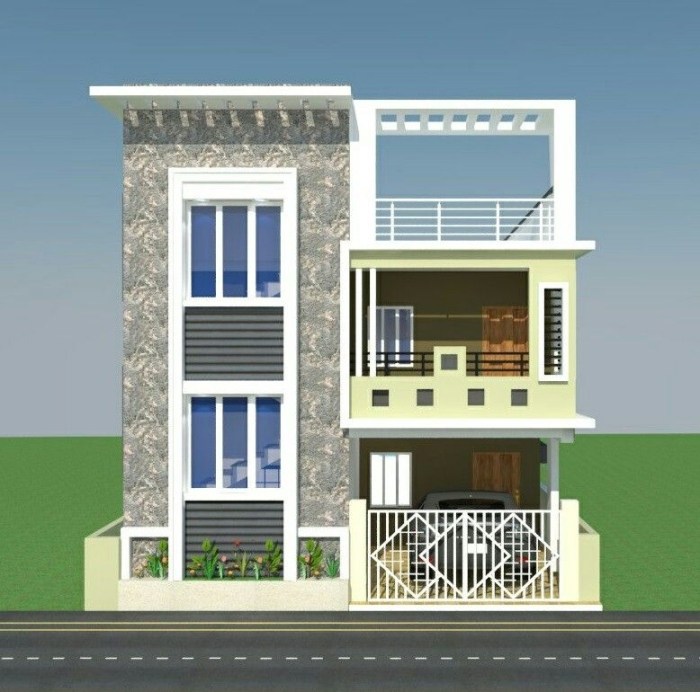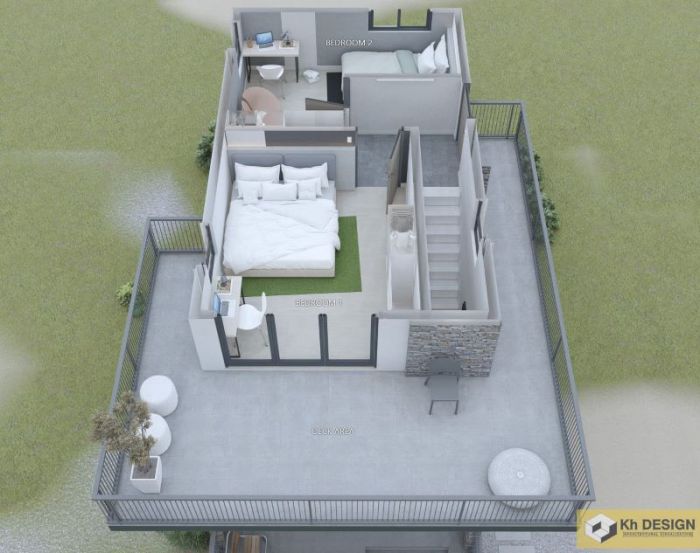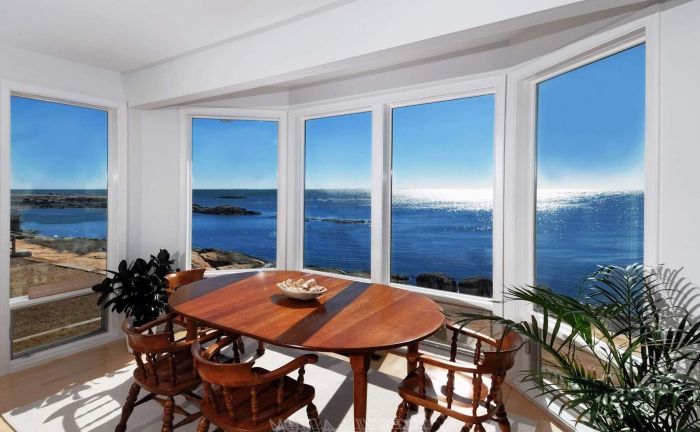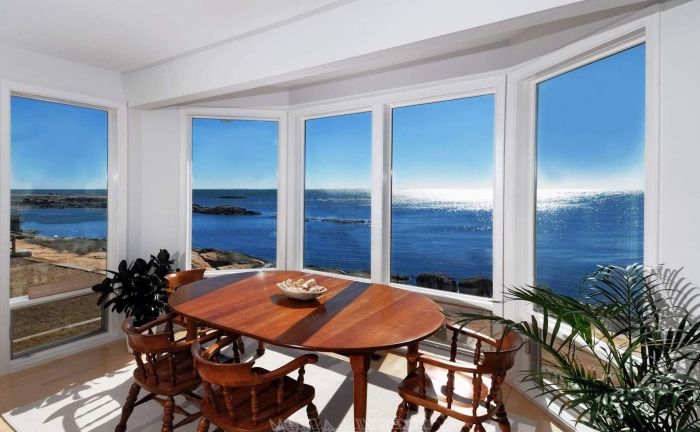2nd floor house interior design presents a unique set of opportunities and challenges. While often considered the private domain of bedrooms and bathrooms, the second floor can be transformed into a haven of personalized comfort, stylish functionality, and even dedicated spaces for work or play.
This guide explores the key considerations for creating a captivating and functional 2nd floor that reflects your individual style and needs.
From maximizing natural light and creating a welcoming atmosphere to optimizing space and functionality, we’ll delve into the intricacies of designing a second floor that feels both beautiful and practical. Whether you’re dreaming of a serene retreat, a vibrant family hub, or a dedicated workspace, this comprehensive guide provides insights and inspiration to bring your vision to life.
Understanding the 2nd Floor Layout

The second floor of a house is often where the private spaces are located, including bedrooms, bathrooms, and sometimes even additional living areas. The layout of this floor can significantly impact the functionality and overall feel of the home.
Common 2nd Floor Layouts
Understanding common 2nd floor layouts is essential for planning and designing your space. Here are some typical configurations:
- Master Suite with Ensuite Bathroom:This is a popular layout, featuring a spacious master bedroom with a private bathroom. The master suite often includes a walk-in closet, providing ample storage space.
- Multiple Bedrooms with Shared Bathroom:In this configuration, multiple bedrooms share a single bathroom. This is a common layout for families with children or smaller homes.
- Guest Room or Home Office:Some 2nd floor layouts include a guest room for visitors or a dedicated home office space, offering flexibility and additional functionality.
- Bonus Room or Family Room:Depending on the house size and design, the 2nd floor may include a bonus room that can serve as a family room, playroom, or home theater.
Advantages and Disadvantages of Different Layouts
Each 2nd floor layout has its own advantages and disadvantages, impacting factors like natural light, privacy, and flow.
- Natural Light:Bedrooms located on the south side of the house tend to receive more natural light, which can create a brighter and more inviting space. However, consider the potential for heat gain during summer months.
- Privacy:Master suites located away from other bedrooms provide more privacy, while bedrooms clustered together may require additional soundproofing for noise reduction.
- Flow:A well-designed layout with a central hallway or open floor plan promotes easy movement and access to different rooms. Avoid cramped or narrow hallways that can hinder circulation.
Maximizing Space and Functionality
There are several creative strategies for maximizing space and functionality on the 2nd floor.
- Built-in Storage:Utilizing built-in storage solutions, such as custom closets, shelves, and drawers, can optimize space and keep clutter at bay.
- Multi-Functional Rooms:Creating multi-functional rooms, like a bedroom that doubles as a home office, can enhance flexibility and maximize space usage.
- Open Floor Plans:Open floor plans can create a sense of spaciousness and flow, particularly in smaller homes.
- Skylights and Windows:Maximizing natural light through skylights and large windows can create a brighter and more inviting atmosphere.
Addressing Challenges of 2nd Floor Design

Second-floor spaces often present unique design challenges due to their location and structural characteristics. Limited natural light, sloping ceilings, and smaller room sizes are common issues that can affect the overall functionality and aesthetic appeal of these areas. However, with thoughtful planning and creative solutions, you can transform these challenges into opportunities to maximize the potential of your second floor.
Maximizing Natural Light
Limited natural light is a frequent concern in second-floor spaces, particularly those with small windows or obstructed views. To combat this, consider implementing strategies that enhance light penetration and create a brighter atmosphere.
- Utilize light-reflecting surfaces: Incorporate mirrors, metallic accents, and light-colored walls and furniture to reflect existing light and create a sense of spaciousness.
- Maximize window size and placement: If possible, consider expanding existing windows or adding skylights to increase natural light inflow. Strategically placing windows to face the sun’s path can also enhance natural light exposure.
- Employ light-colored window treatments: Opt for sheer curtains or blinds that allow natural light to filter through while maintaining privacy.
Designing with Sloping Ceilings
Sloping ceilings, often found in attic conversions or loft spaces, can add character but also present design challenges. The key is to embrace the unique geometry and create a functional and aesthetically pleasing space.
- Maximize vertical space: Utilize the height provided by sloping ceilings to create storage solutions like built-in shelves or closets.
- Embrace the unique shape: Design furniture and decor that complements the sloping ceiling, such as low-profile seating or a custom-made bed frame that fits snugly under the incline.
- Divide the space: Consider using partitions or room dividers to create distinct zones within the sloping space, separating areas like sleeping, working, or lounging.
Creating Functionality in Small Rooms
Second-floor rooms are often smaller in size, requiring careful planning to maximize functionality.
- Use multi-functional furniture: Choose pieces that serve multiple purposes, such as a sofa bed or a desk with built-in storage.
- Optimize storage: Incorporate vertical storage solutions like shelves, drawers, and wall-mounted organizers to maximize space and minimize clutter.
- Utilize light colors: Light walls and furniture create a sense of spaciousness, making small rooms feel larger.
Designing a Kid-Friendly 2nd Floor

Transforming a second floor into a haven for children requires careful planning and consideration. Creating a space that is both safe and stimulating for young minds involves a blend of practicality and imagination.
Safety First: Prioritizing Child-Safe Features, 2nd floor house interior design
Safety is paramount when designing a kid-friendly second floor. This means implementing features that minimize potential hazards and promote a secure environment.
- Install Safety Gates:Gates at the top and bottom of the stairs are essential to prevent falls and ensure children can’t access the stairs unsupervised. Choose sturdy gates that are easy to open and close for adults but secure enough to prevent children from climbing over them.
Designing the second floor of a house often involves considering the flow of the space and the best use of natural light. If you’re working with a 1800 sq ft house, you might want to explore ideas for 1800 sq ft house interior design to get a sense of how different rooms can be laid out.
With a well-designed second floor, you can create a peaceful retreat or a lively gathering space, depending on your needs and preferences.
- Secure Windows:Make sure windows are equipped with childproof locks or safety latches. These devices prevent children from accidentally opening windows and potentially falling out.
- Secure Furniture:Anchor heavy furniture, such as bookcases and dressers, to the wall to prevent them from tipping over if a child climbs on them.
- Electrical Outlets:Use safety covers for electrical outlets to prevent children from sticking objects into them.
- Fire Safety:Install smoke detectors on every floor and ensure they are functioning properly. Create and practice a fire escape plan with your children.
Creating a Fun and Engaging Space
Children thrive in environments that stimulate their senses and imagination. A kid-friendly second floor should be a place where they can play, learn, and express themselves freely.
- Designated Play Areas:Designate specific areas for different types of play, such as a reading nook, an art corner, or a play area with toys. This helps to organize the space and encourages focused play.
- Durable Materials:Choose durable and easy-to-clean materials for furniture and flooring. Consider using materials like laminate, vinyl, or rugs that are resistant to stains and wear and tear.
- Bright Colors:Incorporate bright and cheerful colors into the design to create a vibrant and stimulating atmosphere. Use bold colors on walls, furniture, and accessories to add a playful touch.
- Age-Appropriate Furniture:Select furniture that is scaled appropriately for children’s size and needs. Consider using low-lying tables and chairs, comfortable beds, and storage solutions that are easy for them to access.
Organizing and Storing Toys and Belongings
Keeping a child’s room organized can be a challenge. However, with clever storage solutions, it can be a manageable task.
- Open Shelving:Open shelves are a great way to display toys and books while making them easily accessible to children.
- Storage Bins:Use labeled storage bins to organize toys and other belongings. This allows children to easily put away their items and helps to keep the room tidy.
- Under-Bed Storage:Utilize under-bed storage containers or drawers to maximize space and store items that are not used frequently.
Creating Comfortable Sleeping Spaces
A child’s bedroom should be a sanctuary where they can relax and get a good night’s sleep.
Designing the second floor of a house often presents unique challenges, especially when it comes to maximizing space and creating a cohesive flow. For instance, if you’re working with a smaller footprint, you might find inspiration from ideas for 120 sq yards house interior design which can be adapted to fit your needs.
Remember, the key to a successful second-floor design is careful planning and a focus on functionality, which can be achieved through smart use of space and the right furniture choices.
- Comfortable Beds:Choose a bed that is the right size for your child and provides adequate support. Consider a bed with a headboard and footboard for added comfort and stability.
- Cozy Bedding:Use soft and comfortable bedding that is appropriate for the child’s age.
- Nightlights:Install a nightlight or two to provide a sense of security and make it easier for children to navigate their room at night.
Sustainable and Eco-Friendly Design: 2nd Floor House Interior Design
Designing a second floor with sustainability in mind not only benefits the environment but also creates a healthier and more comfortable living space. This approach involves making conscious choices about materials, energy efficiency, and indoor air quality.
Sustainable Materials
Sustainable materials are those that are sourced responsibly, minimize environmental impact during production, and have a long lifespan. Using these materials on the second floor can significantly reduce the carbon footprint of your home.
- Bamboo Flooring:A rapidly renewable resource, bamboo flooring is durable, beautiful, and naturally resistant to moisture and insects. It requires less water and pesticides to grow than traditional hardwoods.
- Recycled Content Materials:Look for building materials that incorporate recycled content, such as countertops made from recycled glass or tiles made from recycled ceramic. This reduces waste and minimizes the demand for virgin resources.
- Natural Fabrics:Choose curtains, rugs, and upholstery made from natural fibers like cotton, wool, or linen. These materials are biodegradable and often require less energy to produce than synthetic alternatives.
Energy-Efficient Lighting
Lighting accounts for a significant portion of a home’s energy consumption. Choosing energy-efficient lighting options can significantly reduce your energy bill and carbon footprint.
The second floor of a house often provides a unique opportunity for design exploration. Whether it’s a master suite with a balcony or a cozy reading nook, the second floor can be transformed into a personal sanctuary. When considering the overall design, it’s helpful to look at the bigger picture of 2 storey house interior design to ensure a cohesive flow throughout the home.
By incorporating elements like natural light, color schemes, and furniture placement, the second floor can be designed to reflect your individual style and create a space you’ll truly love.
- LED Lighting:LED bulbs are highly energy-efficient, lasting much longer than traditional incandescent bulbs and consuming significantly less energy. They also emit less heat, reducing the strain on your HVAC system.
- Natural Light:Maximize natural light by using large windows and skylights. This reduces the need for artificial lighting during daylight hours, saving energy and creating a brighter and more inviting space.
- Smart Lighting Systems:Smart lighting systems allow you to control your lights remotely and automate their operation. This can help you ensure that lights are only on when needed, reducing energy waste.
Eco-Friendly Paint
Traditional paints can release harmful volatile organic compounds (VOCs) into the air, impacting indoor air quality. Eco-friendly paints are formulated to minimize VOC emissions, creating a healthier environment for you and your family.
- Low-VOC Paints:Look for paints labeled as low-VOC or zero-VOC. These paints are formulated to minimize the release of harmful chemicals, reducing the risk of allergies and respiratory problems.
- Natural Paints:Natural paints are made from plant-based ingredients, such as milk paint or clay paint. These paints are often VOC-free and biodegradable, offering a sustainable and healthy alternative.
Reducing Energy Consumption
There are several ways to reduce energy consumption on the second floor and create a more sustainable home.
- Insulation:Proper insulation in the walls and roof can significantly reduce heat loss in the winter and heat gain in the summer, reducing your reliance on heating and cooling systems.
- Energy-Efficient Appliances:Choose energy-efficient appliances, such as refrigerators, washers, and dryers, that have an Energy Star rating. These appliances use less energy and water, reducing your environmental impact and saving money on utility bills.
- Smart Thermostats:Smart thermostats allow you to program your heating and cooling system to adjust automatically based on your schedule and preferences. This can help you save energy by reducing the need for unnecessary heating or cooling.
Promoting a Healthy Indoor Environment
Creating a healthy indoor environment on the second floor is essential for your well-being.
- Proper Ventilation:Ensure adequate ventilation in your second-floor space by opening windows regularly, especially when cooking or cleaning. This helps to remove pollutants and maintain fresh air circulation.
- Air Purifiers:Consider using air purifiers, especially if you live in an area with poor air quality. Air purifiers can help to remove dust, pollen, and other airborne pollutants, improving indoor air quality.
- Natural Cleaning Products:Use natural cleaning products made from plant-based ingredients. These products are safer for your family and the environment than traditional chemical-based cleaners.
Stylish and Sustainable Design Choices
Sustainable design doesn’t have to sacrifice style. Here are some examples of stylish and environmentally responsible design choices for your second floor:
- Reclaimed Wood:Reclaimed wood has a unique character and adds warmth and rustic charm to any space. It’s also a sustainable choice, as it reduces the need for new timber harvesting.
- Upcycled Furniture:Give old furniture a new lease on life by upcycling it. This reduces waste and adds a unique and personal touch to your decor.
- Living Walls:Living walls are a beautiful and sustainable way to bring nature indoors. They provide a natural air filter, improve acoustics, and create a sense of tranquility.
Final Thoughts
Ultimately, designing a successful 2nd floor interior involves a blend of creativity, practicality, and personal touch. By understanding the unique characteristics of this space, embracing design principles, and considering your individual needs, you can create a 2nd floor that is not only aesthetically pleasing but also functional and fulfilling.
Whether you’re embarking on a complete renovation or simply seeking inspiration for a refresh, this guide offers a roadmap to transforming your 2nd floor into a space you’ll love to call home.
Clarifying Questions
What are some common challenges of designing a 2nd floor?
Common challenges include limited natural light, sloping ceilings, and smaller room sizes. These can be addressed through strategic window placement, creative lighting solutions, and smart furniture choices.
How can I make my 2nd floor feel more spacious?
Using light colors, maximizing natural light, incorporating mirrors, and choosing furniture with clean lines can help create a sense of spaciousness.
What are some tips for designing a kid-friendly 2nd floor?
Consider durable materials, bright colors, age-appropriate furniture, designated play areas, and ample storage solutions for toys and belongings.
What are some sustainable design choices for a 2nd floor?
Sustainable choices include using natural materials, energy-efficient lighting, eco-friendly paint, and reducing energy consumption through smart design decisions.




